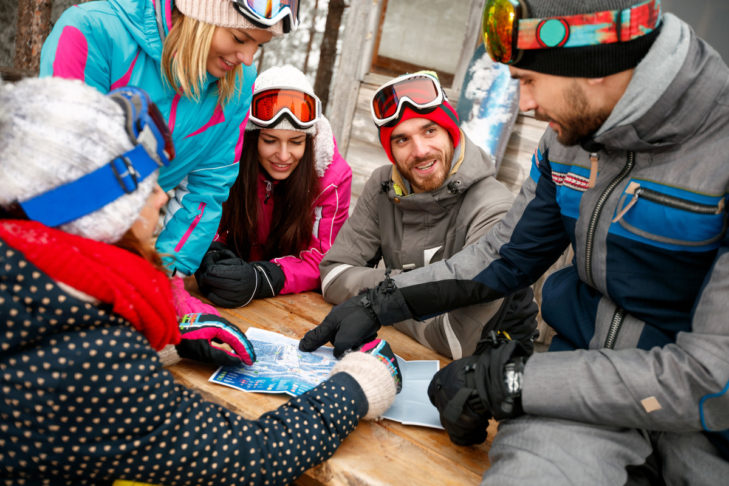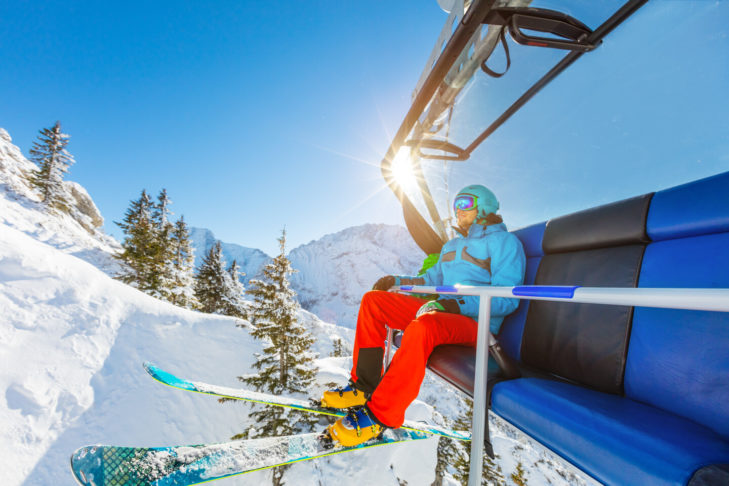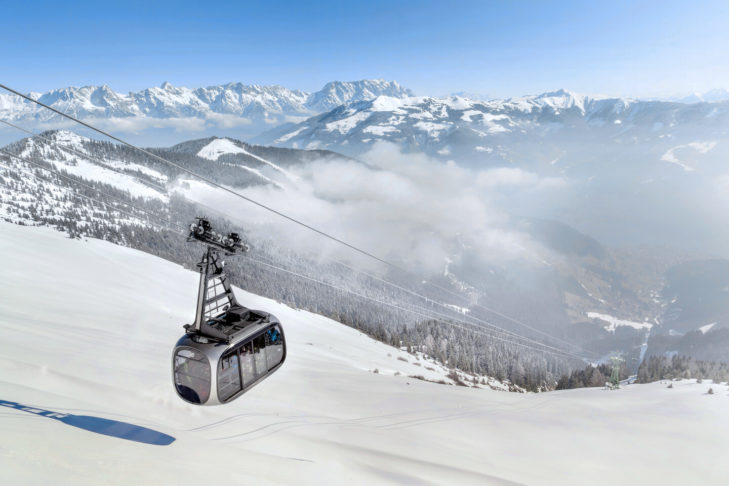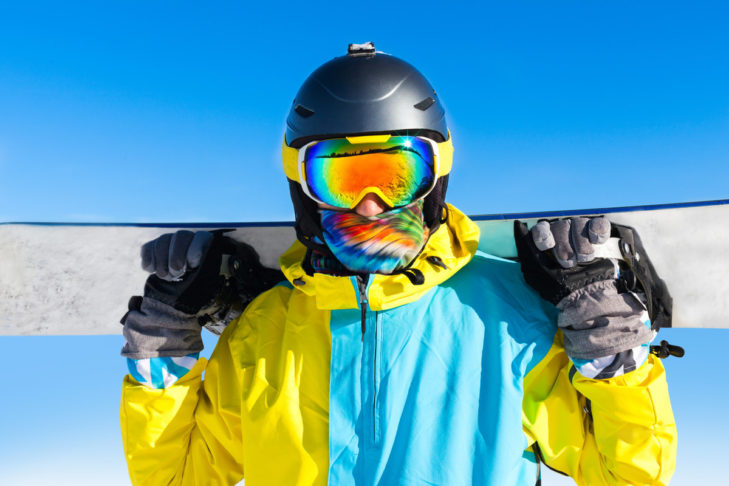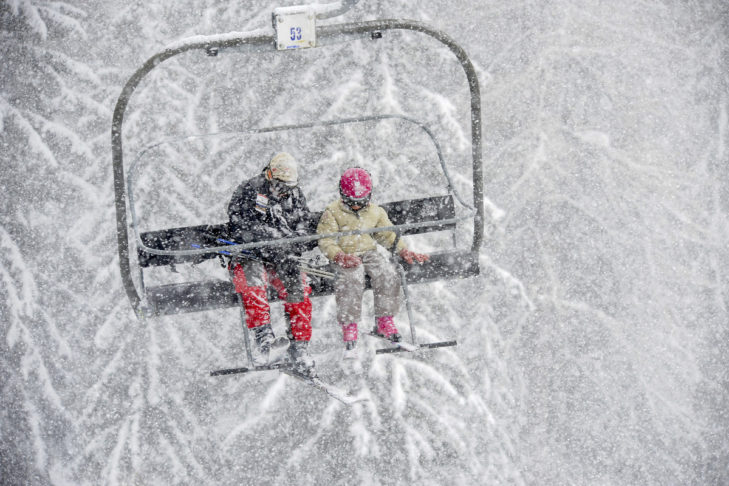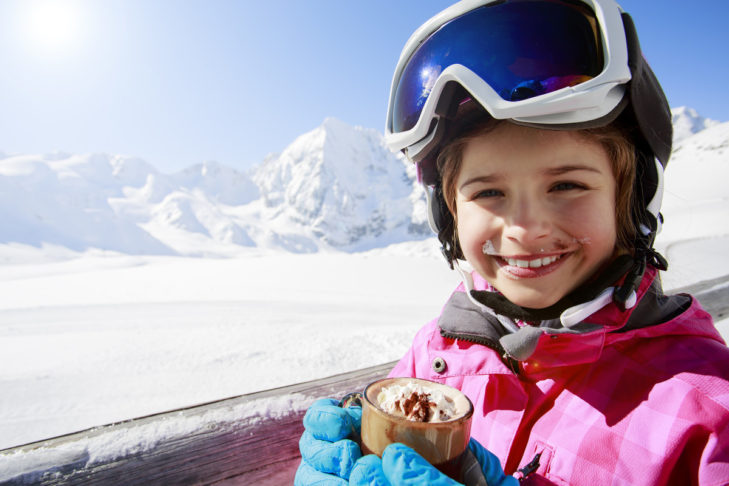Some winter sports enthusiasts rush to the slopes full of enthusiasm after the first snowfall of the season, others prefer to wait for ideal conditions, and still others prefer skiing in the warmer spring months. All these weather conditions have their advantages and disadvantages. It is important that winter sports enthusiasts adapt to the weather conditions in order to stay safe at all times. This ensures that it is not only us at SnowTrex who are in the know that skiing is fun in almost any weather.
No matter the weather, here’s how to handle the slopes safely
Preparation begins before you hit the slopes: winter sports enthusiasts should always be well-rested and physically fit, as this increases concentration. Because attentive skiing is important in all weather conditions so you don’t endanger yourself or others.
Warm up properly
Before hitting the slopes, you should warm up. This not only reduces the risk of injury: the body can react better to unexpected stimuli and external stresses such as strong wind. Warming up shortly before skiing also increases your ability to concentrate, as you are better mentally prepared for the ride and therefore more attentive on the slopes.
Know the route
It is very helpful to look at the route in advance. The better you know the terrain in advance, the calmer and more thoughtful you can react if the weather suddenly changes. For example, if you know where the next hut is, you can go there directly if snow starts to fall. Of course, it is also helpful to ski with a partner instead of alone, and to take the precaution of storing all relevant emergency numbers in your mobile phone. If, for example, you cannot get to safety in time in a heavy snowstorm or get trapped somewhere, you can call for help this way.
In addition, there are many good weather apps such as iSki or Bergfex, which are specially designed for winter sports and with which you can also check the exact weather conditions on site, among other things. It is generally advisable to always double-check the weather forecast and the avalanche situation before setting off.
React to changes in the weather
On the slopes, don’t be too hardheaded about following the plan you made in the morning. If the weather conditions change and you don’t feel safe, it’s best to take a break or end the ski day a little earlier than planned. Safety always comes first.
Even perfect conditions require attentiveness
When it’s finally time to set off, winter sports enthusiasts should always be aware of what different weather and visibility conditions mean for skiing.
For example, the dream conditions of soft fresh snow, bright sunshine, windless air and a temperature between -1 and -6°C get a winter sports enthusiast’s heart pounding. Because these weather conditions are considered by many to be perfect: the sweet spot where everything that makes skiing so enjoyable and beautiful comes together.
- The temperatures are neither so cold that it becomes uncomfortable to ski, nor so warm that the snow melts.
- Without wind, it is also warmer and the snow is not stirred up, which makes for perfect weather and skiing conditions.
- Fresh snow in particular is very pleasant for skiing because it is light and dry. This makes it particularly easy to ski through the snow.
Since powder snow is more than 90% air, it is very soft. When skiing through powder snow, there is hardly any resistance and you virtually glide right through it. If there is also plenty of sunny and no wind, experienced skiers can pick up the pace. If beginners fall, it is at least very softly. It’s no wonder why these weather conditions are the ideal for many.
In the Alps, however, this does not happen often. The soft, dry powder snow is especially rare because it doesn’t get cold enough – as a result, the snow tends to be wet and heavy. The high Alps particularly are rarely without wind. In North America or Japan, on the other hand, these dreamlike weather and snow conditions are more common.
However, it is often precisely these ideal conditions that can lead to accidents on the slopes. The weather is nice, the visibility is good, you can go faster, falling down is soft – all this tempts you to go too fast and not pay much attention: skiing fast can cause your weight to quickly shift too far backwards, which then causes the skis to lose contact with the snow. This in turn can cause you to lose your balance or ski uncontrollably. Therefore, you should ski at a reasonable speed and not become overconfident.
Moreover, those who do not expect any difficulties or dangers when skiing quickly become careless. Studies have shown that a high sense of safety even leads to more injuries in sports. This means: you should always ski with full concentration, especially in ideal weather conditions.
Skiing safely in strong winds
Usually, though, winter sports enthusiasts do not always have perfect conditions. It can be very stormy, especially on high peaks. Some love to have the wind whipping around their ears when they are skiing downhill. There is nothing wrong with that, as long as you are wearing the proper attire, adjust your skiing style, and stop when the gusts are too strong.
The rule of thumb is: when the ski lifts close, it’s too windy to ski. However, this is somewhat simplified, as some cableways and lifts can withstand winds of up to 100 km/h, while others stop operating at wind speeds of around 50 km/h. Experts say that winter sports enthusiasts usually still ski safely at wind speeds between 50 and 60 km/h.
However, skiing can become unpleasant at wind speeds of over 35 km/h without additional protection. Of course, this depends on the wind direction as well as the temperature. Depending on the outside conditions, the wind is felt to be more or less strong. Body weight can also play a role in how stable you feel on the skis at what wind speed.
As soon as you feel that the wind is endangering your balance, you should slow down. If even stable skiing is no longer possible, ski slowly and carefully off the piste and wait for the weather conditions to improve or perhaps even just call it a day.
Suitable clothing protects you from the wind
If you ski in windy weather, you should always be dressed appropriately. Because even if the temperatures don’t seem that cold, the wind chill factor makes the body freeze faster. You start to feel the wind chill factor at temperatures below 10°C: the stronger the wind blows and the colder the temperatures are, the further the outside temperature feels like it is dropping. For example, -10°C at a wind speed of 10 km/h feels like -15.2°C. If the wind speed increases to 25 km/h, it feels like -18.7°C.
The best way to combat this is to wear suitable clothing, preferably in the form of several breathable layers. Clothing for winter sports should therefore be breathable, because clothing that is too tight inhibits blood circulation, making it even easier to freeze. In addition, the combination of moisture, in this case sweat, and wind and cold also makes you freeze faster. Winter clothing is usually made of special functional fibres that are breathable and insulate well.
The typical onion method for winter sports includes thermal underwear made of functional fibres, ski socks, a long shirt also made of functional fibres, a ski pullover, water-repellent ski pants and ski jacket, as well as gloves, a scarf and, if needed, a face mask. Materials such as down or polyamide are recommended, as they allow air to circulate, but also keep you warm and repel wind and water well.
In addition, you should also listen to your body when skiing in windy conditions. If you are freezing badly, the wind is whipping up the snow so much that visibility is restricted, or keeping yourself stable becomes difficult, then it is high time to stop.
Wind changes the snow
But the wind not only influences how we feel when skiing, it can also affect skis’ material. When strong winds and cold temperatures (from -20°C) come together, sharp points form on the snow crystals. These then stick to the skis and can destroy a layer of material. This is certainly an extreme situation, but the influence of the wind on the top layer of snow should not be underestimated.
Wind can also quickly turn soft new snow into grainy old snow. Old snow and new snow do not combine, however, so they form a very slippery surface. This makes skiing unstable and increases the risk of snow slides and avalanches. Anyone who notices this should not panic, but ski very carefully and move away from the piste slowly but surely.
Skiing in snowfall
Skiing in snowfall can also be dangerous under certain circumstances. This is because, despite its beauty, snowfall can also be unpredictable when skiing, as it is never entirely clear how the fresh snow will interact with the underlying snow.
For example, if it is only snowing lightly and the temperatures are below freezing, the falling fresh snow provides a pleasant soft surface through which you can glide unhindered.
However, when the snowfall turns into a blizzard, caution is advised. Not only is visibility severely impaired, but the humid air also causes body temperature to drop rapidly. This is exacerbated by the wind, so there is a risk of hypothermia.
If you notice that the wind and snowfall are becoming more intense before setting off, it is better to take a break and wait until the weather improves. If you notice on the way that the snowfall is getting heavier, you should try to get back to the valley or to the next mountain hut as quickly as possible and wait there.
In warmer temperatures around freezing point, on the other hand, snowfall has a completely different effect. Here, unlike powder snow, the new snow is wet and heavy. This makes it stick better, but at the same time means that the skis no longer glide smoothly through it. This happens especially often in spring, when it also gets warmer in the mountains. Skiing through the heavy, wet snow becomes more strenuous. However, if you don’t lean forwards so much and use the poles skilfully, the strain on your joints is automatically reduced.
Skiing on ice
When it hasn’t snowed for a long time and the temperatures are cold, a layer of ice often forms. Because winter sports enthusiasts ski on the same layer of snow again and again and no new snow falls, the snow that is already on the ground is compressed more and more until a hard layer forms. However, the ice makes it more difficult for winter sports enthusiasts to make controlled turns.
On the other hand, an even layer of ice can also be a good base for fast descents. You can practice on it to improve your stability.
A good skiing technique on ice is to ski more diagonally instead of the usual soft curves and to apply pressure along the entire length of the edge. This allows you to make very wide turns along the soft snow and around the ice slabs. However, this puts more pressure on knees and ankles. The boots must therefore be very tightly fastened. The upper body should not lean too much to maintain stability.
If you are not up to these conditions or cannot master these techniques and control your descent, it is better to spend the day comfortably in the ski hut when there is ice on the piste.
Extreme cold
Extreme cold, i.e. double-digit negative temperatures, also affect skiing. Winter sports enthusiasts should always bear in mind that temperatures can fluctuate greatly between the mountain and the valley and between the morning and the afternoon. For every 1,000 metres of altitude, the temperature drops by about six degrees.
Staying warm is therefore essential. In addition to suitable protective clothing, it is also important to plan for small snacks. These can be fruit or dried fruit as well as muesli bars or wholemeal bread. Anything that contains lots of good carbohydrates and provides energy (and thereby warmth) without being too heavy on the stomach is recommended. If you don’t eat enough, your metabolism will slow down and you will freeze more quickly. Also don’t forget to drink. Not having enough liquids leads to lack of concentration, weakness and tiredness.
In addition, regular breaks in the warm are not only cosy, but also important, as the body gets tired more quickly in the cold. This gives both young and old an excuse to warm up nicely with a hot chocolate before continuing.
Winter sports enthusiasts are also able to stay warm by planning their routes well: if you tend to stick to the slopes with heated lifts in very cold weather conditions, you won’t freeze too much on the ascent.
However, the frosty temperatures also affect the equipment – for example, the bindings can freeze. During breaks, it can help to briefly step out of the bindings and back in again to thaw the mechanism.
Warm weather and slush
At the other extreme are warm temperatures when skiing, i.e. around or above freezing point. These cause the snow to melt. In the first days of spring, this often happens during the day when the thermometer climbs above zero degrees. At night, the temperatures drop again, the melted snow freezes and the result is an icy slope or slushy snow.
This has two effects on skiing: As with damp snow, the slush is heavy, so you have to use a lot of force when skiing. In addition, the snow sticks under the skis and sucks them to the ground. But this also gives you a somewhat firmer footing.
If you fall down, you will notice the second effect of the icy slush: it burns your skin. You can avoid skiing on the slush by getting on the slopes early, when it is not yet warm. Early risers are rewarded with pleasant temperatures and unobstructed descents.
Pay attention to the weather forecast and adjust accordingly
From snowfall to ice to strong winds: skiing does not always go hand in hand with the best weather conditions. Therefore, it is important to read the weather forecast carefully and prepare well for the respective weather conditions with the appropriate skiing style and the right equipment.
With a combination of the right attitude, good protective clothing and suitable skiing style, you can have fun skiing in almost all weather conditions!
FAQs on weather and visibility conditions for skiing
When are the best weather conditions for skiing?
Every winter sports enthusiast has personal preferences, but sunny and windless weather with temperatures between -1 and -7°C and a thick layer of fresh snow are considered by many to be the ideal conditions.
Is there any need to worry when skiing in ideal weather conditions?
Yes and no. It is precisely the good conditions that tempt winter sports enthusiasts to ski too fast and too recklessly. Therefore, you should always ski carefully and prudently even in the best weather conditions.
Can strong wind damage equipment?
When strong winds coincide with cold temperatures, the snow crystals form sharp points. These can indeed damage the underside of the skis.
Is skiing allowed when it is snowing?
As long as the ski lifts are running and visibility is not too badly affected, skiing in snowfall can be very enjoyable. Also, since you never know for sure how the fresh snow will behave, you should always ski at a reasonable speed. If there is a strong wind in addition to the snowfall, not only is visibility severely restricted, but there is also a risk of hypothermia. In this case, you should refrain from ski runs.
How do I ski safely over ice?
When skiing over icy surfaces, a combination of a strong edge and pressure on the length is important in order to get a good “grip” on the ground and remain stable. Those who have not mastered this technique should avoid icy slopes.
Why is it more difficult to ski in wet snow than in powder snow?
Wet snow is heavy, so the skis stick to it relatively strongly. Powder snow, on the other hand, is very soft and light and also dry. For winter sports enthusiasts, this means that they have to exert less effort to ski through soft snow – they feel like they are gliding. Skiing through wet snow requires more strength and is therefore perceived as more strenuous.


